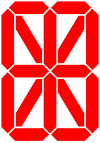Fourteen-segment display

A fourteen-segment display (sometimes referred to as a starburst display or a "Union Jack" display) is a type of display based on 14 segments that can be turned on or off to produce letters and numerals. A seven-segment display suffices for numerals and certain letters, but to unambiguously render the roman alphabet requires more detail. [1] It is an extension of the more common seven-segment display, having an additional four diagonal and two vertical segments with the middle horizontal segment broken in half. The sixteen-segment display breaks all three horizontal segments in half.
A decimal point and/or comma may be present as an additional segment, or pair of segments; the comma (used for triple-digit groupings or as a decimal separator in many regions) is commonly formed by combining the decimal point with a closely 'attached' leftwards-descending arc-shaped segment.

Electronic alphanumeric displays may use LEDs, LCDs, or vacuum fluorescent display devices. The LED variant is typically manufactured in single or dual character packages, allowing the system designer to choose the number of characters suiting the application.
Applications
Multiple-segment display devices use fewer elements than a full dot-matrix display, and may produce a better character appearance where the segments are shaped appropriately. this can reduce the number of driver components and power consumption.
Fourteen-segment gas-plasma displays were used in pinball machines from 1986 through 1991 with an additional comma and period part making for a total of 16 segments.


Sixteen-segment displays were originally designed to display alphanumeric characters (Latin letters and Arabic digits). Later they were used to display Thai numerals[2] and Persian characters [3].
Fourteen and sixteen-segment displays were used to produce alphanumeric characters on calculators and other embedded systems. Applications today include displays fitted to telephone Caller ID units, gymnasium equipment,VCRs, car stereos, microwave ovens, slot machines, and DVD players.
Such displays were very common on pinball machines for displaying the score and other information, before the widespread use of dot-matrix display panels.
Incandescent lamp version
Multiple segment alphanumeric displays are nearly as old as the use of electricity. A 1908 textbook [4] describes an alphanumeric display system using incandescent lamps and a mechanical switching arrangement. Each of 21 lamps was connected to a switch operated by a set of slotted bars, installed in a rotating drum. This commutator assembly could be arranged so that as the drum was rotated, different sets of switches were closed and different letters and figures could be displayed. The scheme would have been used for "talking" signs to spell out messages, but a complete set of commutator switches, drums and lamps would have been required for each letter of a message, making the resulting sign quite expensive.
Cold Cathode Neon "Nixie" version
A few different versions of the fourteen segment display exist as cold-cathode neon lamps. These are commonly called a Nixie tube by enthusiasts. Instead of using a filament as the incandescent versions do, these use a cathode charged to a 180V potential which causes the electrified segment to glow a bright orange color.[5]
See also
Display Configurations
References
- ^ Richard C. Dorf (ed.) The Electrical Engineering Handbook, CRC Press, Boca Raton, 1993, ISBN 0-8493-0185-8 page 1770
- ^ [1] Standard sixteen segmented display for Thai numerals IEEE Transactions on Consumer Electronics, Volume 35 Issue 4 1989
- ^ [2] Alphanumeric Persian characters using standard 16-segment displays, IEEE Transactions on Consumer Electronics Volume 37 No. 1, 1991
- ^ I. C. S. Reference Library Volume 4B, Scranton, International Textbook Company, 1908, no ISBN
- ^ [3] Burroughs b5791 Tube Data
